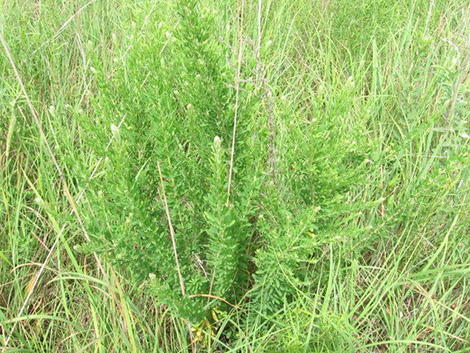Grassland Nesting Passerine and Prairie Butterfly Response to Prescribed Fire and Livestock Grazing Used to Control Sericea Lespedeza
 Investigators:
Investigators:
Sarah Ogden, M.S. Student
Project Supervisors:
Dr. David Haukos
Funding:
National Fish and Wildlife Federation
Cooperators:
Dr. KC Olson
Jack Lemmon, M.S.
Jonathan Alexander, M.S.
Location:
Geary County and Woodson County, Kansas
Completion:
December 2016
Status:
Completed
Objectives:
Measure abundance grassland nesting passerines in grassland patches subjected to fire or grazing treatments.
Measure diversity and density of the butterfly community in patches subjected to fire or grazing treatments.
Progress and Results:
Sericea lespedeza (Lespedeza cuneata) is an invasive forb that reduces the abundance of native grasses and forbs in tall-grass prairie by up to 92%. The spread into the Flint Hills is problematic for the ranching community because the plant's high levels of condensed tannins, which cause it to be unpalatable to cattle, ultimately reduces cattle weight gain on invaded pastures. Traditional land management tools in the Flint Hills (i.e., spring prescribed fire, cattle grazing, and herbicide use) are ineffective against sericea lespedeza but there is encouraging evidence that late-growing season prescribed fire and grazing by tannin tolerant herbivores are effective at controlling the invasion. Before promoting these practices, however, it is important to determine the effects they have on the native tall-grass prairie wildlife communities. A 50-ha study site in Geary County, KS was established and divided into 9 patches, each randomly assigned to one of three treatments: mid-April burn (spring fire), early August burn (mid-summer fire), or early September burn (late summer fire). Data from 2015 indicate that abundance of grassland nesting passerines is similar among all treatments and grasshopper sparrows (Ammodramus savannarum) display a trend of being more abundant in mid- and late summer fire treatments compared to spring fire treatments. Butterfly diversity and density are similar among all treatments. A 250-ha study site in Woodson County, KS has been established and divided into 8 pastures, each randomly assigned to one of two treatments: steer grazing followed by sheep grazing (steer + sheep grazed) or steer grazing followed by rest (steer grazed). Data from 2015 indicate that abundance of grassland nesting passerines is similar among all treatments and grasshopper sparrows show a trend of being more abundant in steer + sheep grazed pastures than in steer grazed pastures. Butterfly diversity is higher in steer grazed pastures than in steer + sheep grazed pastures, whereas butterfly density is higher in steer + sheep grazed pastures than in steer grazed pastures. Future analyses will incorporate data collected during the 2016 field season. Additionally, nest survival and reproductive success will be estimated for grassland nesting passerines within each of the treatments. The information regarding the native tall-grass prairie bird and butterfly communities will help land and wildlife managers determine whether it is responsible to promote the use of summer prescribed fire and/or grazing by tannin-tolerant herbivores to control sericea lespedeza.
Products:
Thesis:
Ogden, Sarah (M.S., 2016; advisor Haukos) Responses of grassland birds and butterflies to control of sericea lespedeza with fire and grazing. Master's Thesis, Division of Biology, Kansas State University.
Professional Presentations:
Ogden, S. B., D. A. Haukos, K. C. Olson, J. Alexander and J. Lemmon. 2017. Grassland Bird Response to Season of Burn and Grazing Intensity. Midwest Fish and Wildlife Conference, Lincoln, NE.
Ogden, S., D.A. Haukos, K.C. Olson, and J. Alexander. 2016. Birds, butterflies, and burning: wildlife response to summer fire used for invasive plant control in tall-grass prairie. Annual Meeting of The Wildlife Society, Raleigh, NC.
Ogden, S. 2016. Sericea Lespedeza Control: Short- and Long-Term Outlooks on the Effects on Prairie Butterflies. Kansas Natural Resources Conference, Wichita, KS.
Ogden, S. 2016. Grassland bird and butterfly responses to summer fire: Species- and community-level analyses tell different, yet encouraging stories. Annual Graduate Research Forum, Division of Biology.
Ogden, S. 2016. Grassland Bird Community Response to Sericea lespedeza Control Using Fire and Grazing. Society for Range Management Annual Conference, Corpus Christi, TX.
Ogden, S., D. Haukos, Olson, K.C. and Lemmon, J. 2016. Lesser Prairie-Chicken Habitat and Movement Response to Patch-Burn Grazing. 76th Midwest Fish and Wildlife Conference, Grand Rapids, MI.
Ogden, S.B., D.A. Haukos, K. Olson, J. Lemmon, J. Alexander. October 2015. Species-Specific Responses of Grassland Birds to Sericea Lespedeza Control using Fire and Grazing. Kansas Ornithological Society. Emporia, KS.
Ogden, S., D. Haukos, K. Olson, and J. Lemmon. 2015. Response of grassland passerine communities to tall-grass prairie restoration using summer fire and sheep grazing. Annual meeting of the Central Mountains and Plains Section of The Wildlife Society, Manhattan, Kansas.
Ogden, S., D. Haukos, K.C. Olson, and J. Lemmon. 2015. Grassland Bird Response to Sericea Lespedeza Control using Fire and Grazing. Joint meeting of American Ornithologists' Union and Cooper Ornithological Society, Norman, OK.